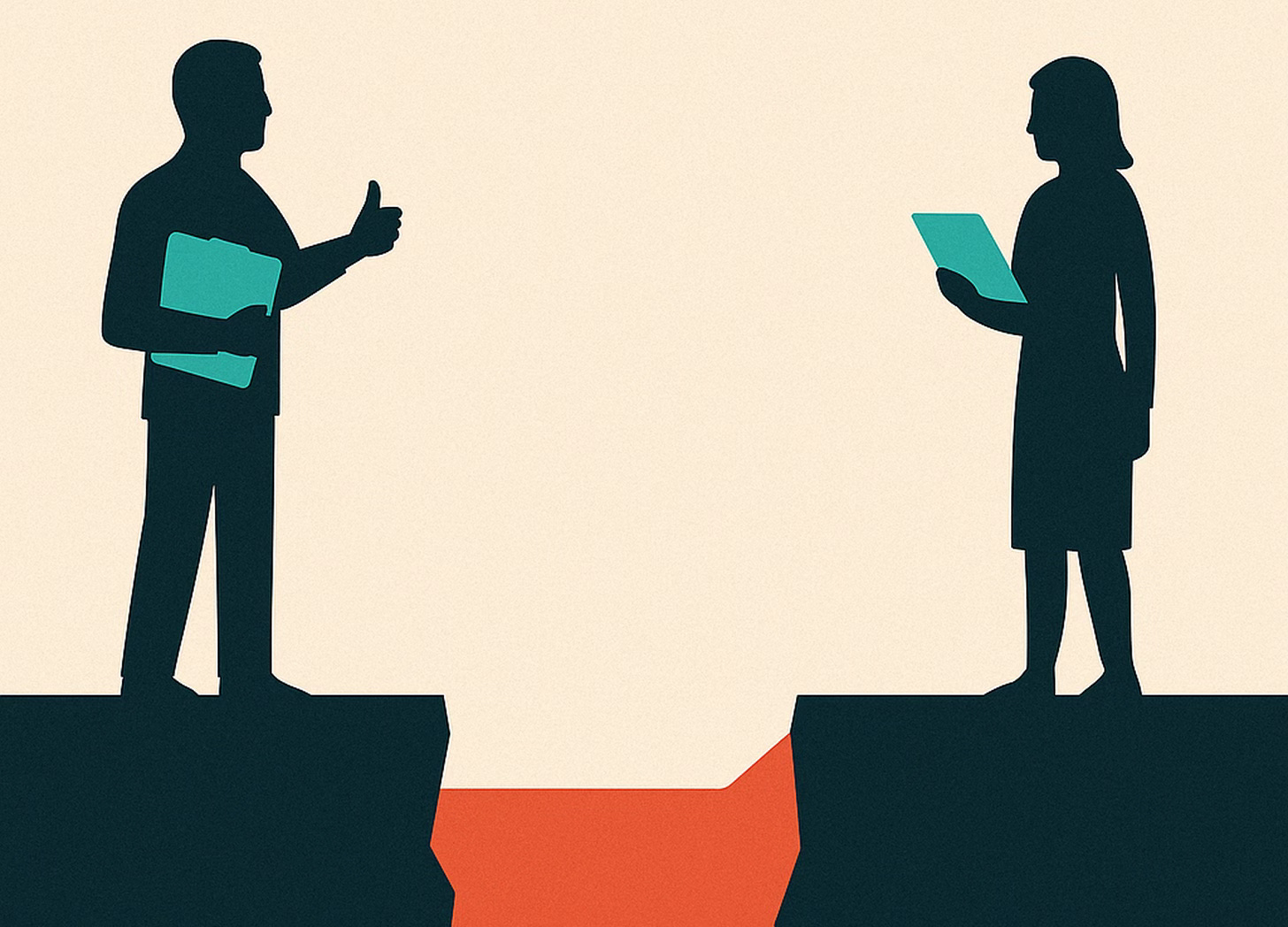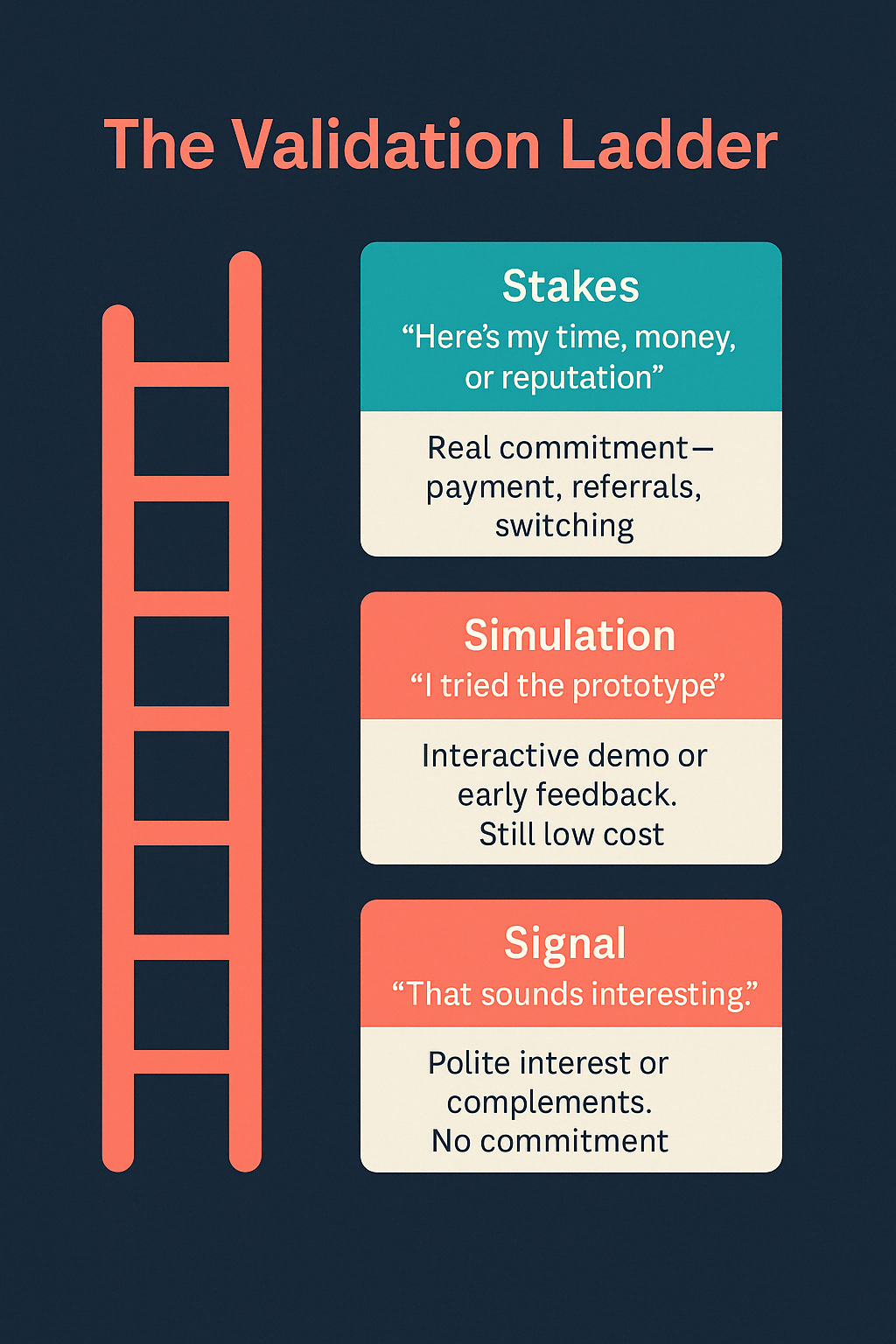The Validation Gap
Why Product Discovery Still Fails (and How to Fix It)
🎧 Now a Podcast Conversation
This post sparked a new episode of The Product Leader’s Playbook, where our AI hosts unpack why product discovery so often fails.
→ 🎙 Listen on Spotify | Listen on Apple Podcasts
“We see things not as they are, but as we are.”
— Anaïs Nin
In product discovery, perception is a dangerous thing.
You run five user interviews. They all say your idea sounds useful. One even calls it “brilliant.” You share an early Figma prototype in Slack, and people start reacting with emojis. A few PMs in your network tell you you're onto something.
But you’re not.
You’ve just collected signals, not validation.
This is the trap: we confuse positive feedback with proof. We assume that interest will translate to adoption. We treat warm words as green lights.
And then we ship something nobody actually wants.
This is the Validation Gap - the space between what we think we’ve learned and what’s actually been proven. And it’s one of the biggest reasons product discovery still fails.
🧱 The Core Mistake
The biggest mistake in product discovery is equating feedback with validation.
We ask users what they think - and when they tell us what we hope to hear, we assume we’ve found product-market fit. But thinking ≠ doing. And “That sounds cool” ≠ “I’ll use it, pay for it, or switch today.”
Most product teams collect signal and treat it like evidence:
A user says they might use it? We count that as intent.
They click through a prototype? Must be proof of demand.
They answer a survey with a positive response? Time to build.
But the harsh truth is: validation doesn’t happen until there’s something at stake.
Until a user is giving up time, money, effort, or reputation, all you’ve gathered is noise. Encouraging noise, maybe, but noise nonetheless.
Here’s what this looks like in the wild:
A team builds a “validated” feature that nobody uses.
A startup preps for launch based on interviews… and hears crickets.
A founder raises money on a pitch deck full of “enthusiastic early feedback”, but no one actually signs up.
Why? Because discovery didn’t cross the threshold into commitment.
The result? The Validation Gap swallows months of work and countless good ideas.
🧗♂️ The Validation Ladder
To close the validation gap, you need a simple way to measure how real your feedback actually is.
Here’s a mental model I use:
Signal → Simulation → Stakes
Visual: The Validation Ladder – a simple model for measuring the depth of user validation.
Signal
“That sounds interesting.”
This is the lowest rung, and the most deceptive.
Signals are positive noises: interest, encouragement, even compliments.
“I’d probably use that.”
“That’s a great idea.”
“We’ve been looking for something like this.”
It feels good. But these signals cost the user nothing. No time, no money, no commitment. They’re telling you what they think you want to hear, or what they believe in theory.
Mistake: Taking polite interest as actionable proof.
Simulation
“I tried the prototype and gave feedback.”
This is one step closer to reality - interactive mocks, clickable flows, and early demos. You’re testing usability, reactions, and workflow logic.
Simulations are helpful. They reveal confusion points, spark real conversations, and show how users interact with your idea. But again, the cost is low. There’s no real skin in the game.
Best used for: UX friction, first impressions, workflow testing
Not enough for: Willingness to buy, switch, or integrate
Stakes
“Here’s my time, money, or reputation - because I want this.”
Now you’re getting somewhere.
Real validation happens when people are willing to do something that costs them. That might mean:
Entering a credit card (even if not charged yet)
Committing to a pilot program
Referring others (putting social capital on the line)
Switching from a current solution
Reaching out unprompted to ask when it’s ready
When users take action, they reveal what surveys and interviews can’t: real intent.
But What If You're Too Early for Stakes?
If you’re building something brand new, you might be thinking:
“We’re not ready for pilots or payments yet. All we have is a prototype.”
That’s not a dealbreaker, it’s reality for most early-stage teams.
You can’t always demand high-stakes validation right out of the gate.
What matters is knowing where you are on the ladder, and what that means.
The danger is when teams treat signal or simulation like stakes, and assume they’ve already de-risked the idea.
You can build on signal. Just don’t build on false confidence.
🧨 Where It Breaks Down
Most product discovery doesn’t fail because teams aren’t listening.
It fails because they’re listening to the wrong signals, and thinking the job is done.
Here’s where things go sideways:
⚠️Signal gets mistaken for demand.
A handful of users say your idea sounds promising.
You interpret that as intent to buy.
You spin up a sprint.
But when the feature ships, no one clicks. No one adopts. And no one remembers saying it was a good idea.
Mini-Case:
I worked with a B2B SaaS team that ran a round of user interviews. Everyone said the proposed dashboard was “exactly what they needed.” They fast-tracked development and shipped it. Three months later, usage was below 5%. Turns out, customers liked the idea, but their real workflow lived in spreadsheets, and switching would have required retraining an entire department. They had signal. Not stakes.
⚠️ Simulation gets mistaken for product-market fit.
Your prototype performs well in a usability test.
The flow is smooth. The feedback is positive.
You assume you’re ready to launch.
But in the real world, being usable isn’t the same as being necessary.
Smooth doesn’t mean sticky. It just means easy to ignore.
⚠️ PMs mistake curiosity for commitment.
A potential customer joins your research call.
They seem excited. Maybe they ask smart questions.
They say “keep me posted.”
You walk away thinking they’re a future customer. But weeks later, they haven’t responded. Why? Because interest is easy. Action is hard.
And nobody pays for nice ideas.
These are the subtle ways the Validation Gap creeps in.
It’s not about missing feedback, it’s about misreading it.
Until users are doing something that costs them, you haven’t validated.
You’ve just run a good conversation.
🔒 How to Close the Validation Gap
So how do you go beyond feedback and get to real proof?
You create micro-stakes - small, intentional hurdles that reveal true intent.
The goal isn’t to make things hard.
It’s to make things real.
Here are a few ways to move up the ladder without a finished product:
Ask for a credit card (even if you don’t charge it)
Set up a “Join the waitlist” page with payment details. You can always delay charging, but asking for billing info forces users to pause and consider whether they’re serious.
💡 If they hesitate here, they’ll hesitate when it’s live.
Require effort, not just interest
Invite-only betas, onboarding calls, or multi-step signups can filter for committed users. People who will jump through a hoop today are more likely to show up tomorrow.
💡 Friction isn’t always bad — it filters signal from noise.
Use referrals as a test of belief
Ask users: “Who else should I talk to?”
If someone is willing to put their name behind your idea, even just by forwarding a link, that’s social proof backed by reputation.
💡 A passive yes is cheap. A referral is a real vote.
Track unprompted behavior
Are users following up with you? Sharing your prototype with others? Asking when it will launch?
💡You can’t fake curiosity at scale. Behavior reveals what words hide.
Start small, but be honest
You don’t need to run a full product experiment to get real validation.
But you do need to ask yourself:
“What are users actually giving up to show they care?”
Until they’ve put something on the line, even something small, you haven’t crossed the gap. You’ve just stood on the edge and hoped.
🧩 Closing Thought: The Cost of Certainty
The best product teams aren’t just good at listening.
They’re good at testing.
They know the real question isn’t:
“Did the user like it?”
It’s:
“What were they willing to do because of it?”
Feedback is cheap. Certainty is expensive.
And validation lives in the space where users put something on the line, not just their words, but their time, effort, or money.
“In theory, there is no difference between theory and practice. In practice, there is.”
— Yogi Berra
The next time a user says, “That sounds great,”
ask yourself - great enough to do what?
If there’s no answer, the work isn’t done.
🧭 Before You Go: A Quick Gut Check
Product leaders: What rung of the ladder are you building from right now?
Before you add that new feature to the roadmap or write your next story, ask yourself:
“What are users giving up to show they actually want this?”
If the answer is “nothing yet,” you're still in discovery. And that’s okay, as long as you know you're not done.
🎧 Want to Go Deeper?
🎙 This article is discussed in a podcast episode of The Product Leader’s Playbook, streaming everywhere:
🔹 Spotify
🔹 Apple Podcasts
🔹 YouTube | Amazon Music



